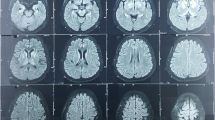Abstract
Myoclonic encephalopathy is a unique clinical syndrome of infants and children that is associated with a neurogenic tumor of ganglion-cell origin in approximately half of cases. A review of the literature as well as our personal experience with two recent infants suggests an imaging approach that includes chest radiography and abdominal computed tomography (CT). Ultrasonography, neck CT, and chest CT myelography may be required in selected patients. An expedient clinical and imaging evaluation of infants and children with opsomyoclonus is important to detect those patients with neurogenic tumors.
Similar content being viewed by others
References
Altman AJ, Bachner RL (1976) Favorable prognosis for survival in children with coincident opso-myoclonus and neuroblastoma. Cancer 37: 846
Bodian M (1959) Neuroblastoma. Pediatr Clin North Am 6: 449
Boltshauser E, Deonna T, Hirt HR (1979) Myoclonic encephalopathy of infants or “dancing eyes syndrome”. Helv Paediat Acta 34: 119
Bowen A, Bergman I (1983) Ultrasonic delineation of left adrenal neuroblastoma in a child with opsoclonus. J Clin Ultrasound 11: 31
Cushing H, Wolbach SB (1927) The transformation of a malignant paravertebral sympathico-blastoma into a benign ganglioneuroma. Am J Pathol 3: 203
deLorimier AA, Bragg KN, Linden G (1969) Neuroblastoma in childhood. Am J Dis Child 118: 441
Dyken P, Kolar O (1968) Dancing eyes, dancing feet. Infantile polymyoclonia. Brain 91: 305
Fortner J, Nicastri A, Murphy ML (1968) Neuroblastoma: natural history and results of treating 133 cases. Ann Surg 167: 132
Gitlow SE, Bertani-Dziedzic L, Dziedzic S (1982) Patterns of catecholamine metabolism in neuroblastoma. In: Pochedly C (ed) Neuroblastoma: clinical and biological manifestations. Elsevier, New York, pp 97–130
Heyer R, Hamann J, Offner G, Vebbing G (1977) Die myoklonische encephalopathie im kindesalter. Monatschr Kinderheilk 125: 640
Hoyt CS (1977) Neonatal opsoclonus. J Pediatr Opthalmol 14: 274
Keating JW, Cromwell LD (1978) Remote effects of neuroblastoma. AJR 131: 299
Kinast M, Levin HS, Rothner AD, Erenberg G, Wachsman J, Judge J (1980) Cerebellar ataxia, opsoclonus and occult neural crest tumor: abdominal computerized tomography in diagnosis. Am J Dis Child 134: 1057
Kincaid OW, Hodgson JR, Dockerty MD (1957) Neuroblastoma: a roentgenologic and pathologic study. Am J Roentgenol Radium Ther Nucl Med 78: 420
Kinsbourne M (1962) Myoclonic encephalopathy of infants. J Neurol Neurosurg Psychiatr 25: 271
Latchaw RE, L'Heureaux PR, Young G, Priest JR (1982) Neuroblastoma presenting as central nervous system disease. AJNR 3: 623
Leder RM (1981) The opsoclonus-myoclonus syndrome: a review of the literature. Bull Los Angeles Neurol Soc 46: 41
McLatchie GR, Young DD (1980) Presenting features of thoracic neuroblastoma. Arch Dis Child 55: 958
Nickerson BG, Hutter JJ (1979) Opsomyoclonus and neuroblastoma: response to ACTH. Clin Pediatr 18: 446
Pochedly C (1976) Neuroblastoma in the neck, chest, abdomen and pelvis. In Pochedly C (ed) Neuroblastoma. Publishing sciences, Acton, Massachusetts, p 60
Resjo M, Harwood-Nash DC, Fitz CR, Chuang S (1979) CT metrizamide myelography for intraspinal and paraspinal neoplasms in infants and children. AJR 132: 367
Rupprecht L, Mortier W (1975) Cerebellare bewegungsstorung and neuroblastoma. Monatschr Kinderheilk 123: 392
Senelick RC, Bray PF, Lahey ME, VanDyk HJL, Johnson DG (1973) Neuroblastoma and myoclonic encephalopathy: two cases and a review of the literature. J Pediatr Surg 8: 623
Solomon G, Chutorian AM (1968) Opsoclonus with occult neuroblastoma. NEJM 279: 475
Stark DD, Moss AA, Brasch RC, deLorimier AA, Albin AR, London DA, Gooding CA (1983) Neuroblastoma: diagnostic imaging and staging. Radiology 148: 101
Young DG (1983) Thoracic neuroblastoma/ganglioneuroma. J Pediatr Surg 18: 37
Author information
Authors and Affiliations
Additional information
Dr. Baker is a Regular Clinical Fellow of the American Cancer Society
Rights and permissions
About this article
Cite this article
Baker, M.E., Kirks, D.R., Korobkin, M. et al. The association of neuroblastoma and myoclonic encephalopathy: an imaging approach. Pediatr Radiol 15, 185–189 (1985). https://doi.org/10.1007/BF02388608
Accepted:
Issue Date:
DOI: https://doi.org/10.1007/BF02388608




